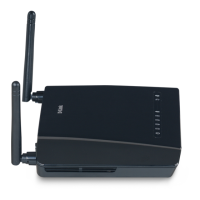






Do you have a question about the D-Link DSL-2740B and is the answer not in the manual?
| downstream data rate | up to 8 Mbps |
|---|---|
| upstream data rate | up to 1 Mbps |
| G.lite downstream data rate | up to 1.5 Mbps |
| G.lite upstream data rate | up to 512 Kbps |
| G.dmt.bis downstream data rate | up to 12 Mbps |
| G.dmt.bis upstream data rate | up to 12 Mbps |
| full rate downstream data rate | up to 24 Mbps |
|---|---|
| full rate upstream data rate | up to 1 Mbps |
| wireless speed | up to 300 Mbps |
|---|---|
| frequency range | 2.4 GHz to 2.484 GHz |
| antennas | 2 non-detachable dipole |
Provides a description of the router, its technologies, and features for internet connectivity.
Explains the wireless access point capabilities and standards for data transmission.
Details ADSL technology, its broadband capabilities, and connection speeds.
Lists and describes the key advantages and functionalities of the DSL-2740B router.
Outlines the various industry standards the router complies with.
Describes the LED indicators on the router's front panel and their meanings.
Details the various ports and connection points on the router's rear panel.
Guides users on the basics of setting up a wireless network for optimal performance.
Discusses environmental factors affecting wireless signal range and performance.
Instructions for powering on the router and checking initial status indicators.
Explains how to reset the router to its original factory default settings.
Details wired connection methods for ADSL and Ethernet ports.
Illustrates how to establish a wired connection between a computer and the router.
Provides an overview of the steps required for router configuration.
Guides on setting up your computer to obtain IP settings automatically via DHCP.
Explains how to access the router's web-based management interface.
Details the process of logging into the router's web interface.
Introduces the router configuration interface and options.
Guides users through the automated setup process for internet connection.
Select the correct connection type (PPPoA, PPPoE, MER, etc.) for your ISP.
Configures PPPoE/PPPoA connection with username, password, and authentication.
Sets up a dynamic IP connection using the 1483 Bridge mode.
Configures a static IP address connection in 1483 Bridge mode.
Configures a static IP address connection using the IPoA mode.
Configures the router for bridge mode internet connections.
Configures the local area network IP address and DHCP settings.
Sets up the wireless network name (SSID) and enables wireless.
Confirms settings and restarts the router to apply changes.
Configure advanced ADSL protocol parameters for optimal performance.
Fine-tune wireless network settings for advanced control and performance.
Secure your wireless network using WEP, WPA, WPA2, and PSK encryption.
Control wireless client access by filtering MAC addresses.
Configure wireless bridge functionality to connect access points.
Prioritize wireless traffic for improved performance of delay-sensitive applications.
Set up firewall policies to protect the network from attacks.
Set up port forwarding rules for inbound WAN traffic.
Dynamically open firewall ports based on outgoing application connections.
Assign a DMZ IP address to a host for direct internet exposure.
Block specific types of outgoing packets from local hosts to the internet.
Allow specific types of incoming packets when the firewall is enabled.
Configure MAC-based filters for packets on WAN interfaces in bridge mode.
Restrict internet access for specific local hosts by MAC address and time.
Control website access by allowing or denying specific URLs or keywords.
Classify traffic, assign queuing priority, and manage network performance.
Specify static routes for data traffic within the LAN or to the WAN.
Configure Routing Information Protocol (RIP) for sharing routing tables.
Create port mapping groups for VLAN and bridging.
Perform diagnostic tests to check router connectivity and system status.
Back up and restore router configuration settings.
Load previously saved configuration files to update router settings.
Reset the router to its original factory default configuration.
Manage user accounts and passwords for accessing the router.
Load the latest firmware to upgrade the router's operating software.
Save current configurations and restart the router.
View basic router information, firmware version, and ADSL status.
Monitor ADSL connection status, rates, and error counters.
View LAN interface details, IP address, and DHCP pool status.
Check WAN interface details, IP address, gateway, and DNS server status.
Monitor ATM interface information, cell counts, and error counters.
View the router's current routing table for network traffic.
View the Address Resolution Protocol (ARP) table for the router's LAN port.
See a list of client devices that have obtained IP addresses from the router.
View the status of authenticated wireless stations connected to the router.
Access and review chronological event log data for troubleshooting.
Details ADSL, ADSL2 standards, and network protocols supported by the router.
Specifies data transfer speeds and physical interface details.
Lists the router's physical dimensions, weight, and operating environment.
Outlines wireless modulation, frequency, channels, and data rates.
Step-by-step guide to set Windows XP to obtain IP settings automatically.
Steps to configure Windows 2000 to obtain IP settings automatically.
Instructions for configuring Windows 95/98 to obtain IP settings automatically.
Steps to configure Windows ME to obtain IP settings automatically.
Guide for configuring Windows NT 4.0 to obtain IP settings automatically.
Describes the installation and use of in-line low pass filters for DSL.
Explains the installation and connection of a three-port filter.